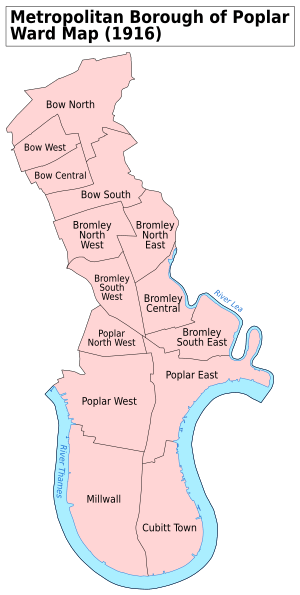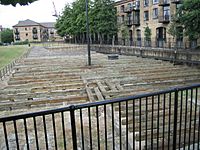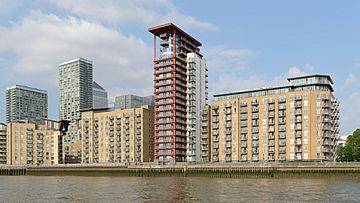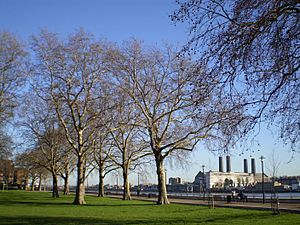Millwall facts for kids
Quick facts for kids Millwall |
|
|---|---|
 The Millwall Dock at night |
|
| OS grid reference | TQ375785 |
| London borough | |
| Ceremonial county | Greater London |
| Region | |
| Country | England |
| Sovereign state | United Kingdom |
| Post town | LONDON |
| Postcode district | E14 |
| Dialling code | 020 |
| Police | Metropolitan |
| Fire | London |
| Ambulance | London |
| EU Parliament | London |
| UK Parliament |
|
| London Assembly | |
Millwall is a lively area in east London, England. It's found on the western and southern parts of the Isle of Dogs. This district is part of the London Borough of Tower Hamlets.
Millwall sits just south of Canary Wharf and Limehouse. It's north of Greenwich and Deptford. To its east is Cubitt Town, and to its west is Rotherhithe. A long part of Millwall is next to the River Thames.
This area was once part of Middlesex County. Then it became part of the County of London in 1889. In 1965, it joined Greater London. In 2011, about 23,084 people lived in Millwall. It includes places like Island Gardens and The Space.
Contents
History of Millwall
How Millwall Got Its Name
Millwall was once a smaller part of Poplar. It was first known as Marshwall. The area got its new name, Millwall, because many windmills were built along the river wall in the 1800s. These windmills helped grind corn and wheat into flour.
Lord Mayor William Cubitt helped make the land stronger. This stopped the area from flooding when snow melted or during high tides.
Millwall's Industrial Past
In the 19th century, Millwall became very industrial. Many factories and homes for dock and shipbuilding workers were built here. One famous factory was William Fairbairn's shipbuilding ironworks. Part of it is still there today as Burrells Wharf.
The famous football team, Millwall F.C., started here in 1885. They were first called Millwall Rovers. Their first nickname was 'the Dockers'. Later, they became 'the Lions'. The team moved across the river in 1910. However, some amateur football pitches still exist near Cubitt Town. A City Farm was also added there later.
The Launch of the SS Great Eastern
On January 31, 1858, the biggest ship of its time was launched from Millwall. This was the SS Great Eastern. It was designed by Isambard Kingdom Brunel. The ship was 211 meters (692 feet) long. It was too wide to launch straight into the river. So, it had to be launched sideways!
A part of the concrete and wood structure from the launch site is now saved. You can see it at Napier Avenue. Because launching such a huge ship was so difficult, this was the last one of its size built on the island. Other shipbuilders kept building warships here for another 50 years.
Building the Millwall Dock
In the 1860s, the large Millwall Dock was built. It stretched from the Thames into the middle of the Isle of Dogs. The dirt and mud dug out to make the dock were piled up. This pile of earth became known as the Mudchute.
Modern Changes in Millwall
Since the 1980s, Millwall has seen many changes. New industrial and office buildings have been built. Many modern homes have also appeared. These new buildings are replacing the older, smaller homes where dock workers used to live.
When the docks closed and factories disappeared, many people lost their jobs. The population of Millwall went down for a while. After World War II, efforts began to rebuild the area. At first, new council houses were built. Later, in the 1980s, private companies started building luxury offices and homes. This caused the population to grow again.
Millwall has several housing areas built by the council. These include West Ferry Estate and the Barkantine Estate. The Barkantine Estate is a large housing area in the northern part of Millwall.
Some people link the name "Millwall" to issues with football fans. Because of this, many residents now prefer to call the area "the Isle of Dogs" or "Docklands".
Sports in Millwall
Millwall Football Club
Millwall is most famous for its football team, Millwall F.C.. It started in 1885 as Millwall Rovers. They were first called 'The Dockers'. Now, they are known as 'The Lions'. The team moved to New Cross in 1910. Even though they haven't played in Millwall for over 100 years, they still keep the name. They now play in Bermondsey.
Millwall Rugby Club
Millwall Rugby Club was formed in 1995. The first team plays in the Essex Division 1 league. They also have women's rugby teams, called the Millwall Venus girls. There's a youth section too, for boys and girls aged eight and up.
Watersports Centre
The Docklands Sailing and Watersports Centre is located at the far west end of the dock. It was opened in 1989. It's a great place for sailing and other water activities.
Politics in Millwall
Millwall has been part of some interesting political events. In a local election in 1993, Derek Beackon won a council seat for the British National Party. This was the first time that party won a seat on a council. However, after a big campaign against it, the BNP lost the seat in the next election.
In 2004, the Respect party also ran in a local election here. The Labour Party usually won this area, but they came in third place. The local Conservative Party won its first ever seat on the Tower Hamlets council. In the 2006 local elections, the Conservatives won all three seats.
The Millwall voting area was changed in 2014. It was mostly replaced by new areas called Canary Wharf and Island Gardens. These new areas tend to vote Conservative. As of 2018, each of these areas has one Conservative and one Labour councillor. These are the only two Conservative councillors on the Tower Hamlets council.
People of Millwall
In the Millwall area of London Borough of Tower Hamlets, about 31% of the people are White British. Another 19.9% are from other White backgrounds. About 14.6% are Bangladeshis.
Many people living in Millwall were born in England (45.1%). Others were born in countries like Bangladesh (6.8%), India (4.7%), and China (4.3%).
When it comes to religion, about 32.1% of people are Christian. 22.0% say they have no religion. 18.0% are Muslim, and 4.9% are Hindu. There are also smaller numbers of Buddhists, Sikhs, and Jewish people.
The population in Millwall is 53% male and 47% female.
Places to See in Millwall
Island Gardens
The historic Island Gardens opened on August 3, 1895. It was opened by a local politician named Will Crooks. This park is almost directly across the river from famous landmarks like the Greenwich Hospital, the Cutty Sark, and the National Maritime Museum.
Historic Pubs
The Ferry House is a pub on Ferry Street. It has been there since the Tudor period (1485-1603). The building you see today dates from 1822. It was a place for ferry passengers to stop for a drink. This was before the Greenwich foot tunnel opened in 1902.
The Ship Inn pub was built in 1835. It is thought that two houses were joined to create this pub. It has always been a pub. It's next to Burrells Wharf, where Isambard Kingdom Brunel worked. He might have visited The Ship during his time there.
The Barkantine Estate
The decision to build the large Barkantine Estate housing area was made in March 1965. The first part opened in 1968. It originally had 634 homes. It also included a shopping area for people to walk through, called The Quarterdeck. A pub called the Tooke Arms was also moved and rebuilt there.
The Space Theatre
The Space is a theatre located inside an old Presbyterian church. The church was built in 1859 for Scottish Presbyterian people. They had moved to the Isle of Dogs to work in the shipyards.
Industry
A large area on the north side of Millwall Dock was home to the West Ferry Printing Works. This was the biggest newspaper printing factory in Western Europe.
Transport in Millwall
Millwall has several ways to get around. You can use the Docklands Light Railway (DLR) from stations like South Quay, Crossharbour, Mudchute, and Island Gardens. The London Underground's Jubilee line is also nearby at Canary Wharf.
Several bus routes run through the area. These include routes 135, 277, D7, D8, and N550.
The closest pier for London River Services boats is Masthouse Terrace Pier.
Millwall is connected to the main road network by Westferry Road (A1206).
Along the north bank of the River Thames is the National Trail Thames Path. This path is great for both cyclists and walkers. It's also part of the National Cycle Route 1 on the National Cycle Network. This route goes all the way from Dover to Shetland.
See also
- Millwall Rugby Football Club
- Millwall brick
- Canary Wharf






